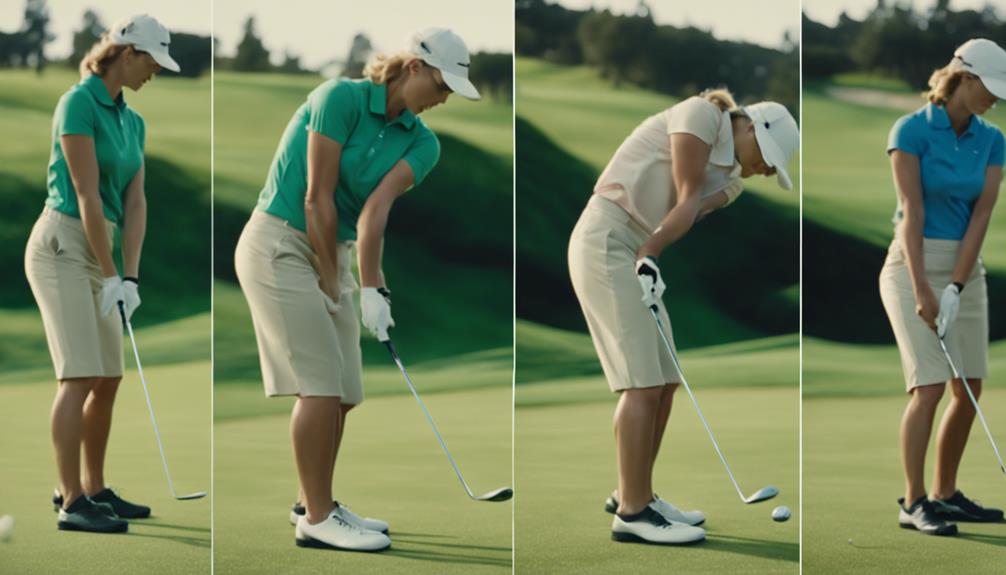- 7 Top Flite Golf Clubs XL for Improved Performance - September 28, 2024
- Top Flite Golf Clubs: Top 5 Reasons to Choose Them - September 28, 2024
- Top 3 Golf Club Fitters for a Perfect Swing - September 28, 2024
When you see the 'X' in golf clubs, it refers to an extra stiff shaft flex designed for golfers with extremely high swing speeds, typically exceeding 110 mph. This means you'll get a stiffer shaft that yields lower trajectories, which can be beneficial for those with powerful swings. However, if your swing speed is slower, you may want to evaluate other flex options like L, A, R, or S, as mismatched flex can lead to difficulties in squaring the clubface and inconsistent shot results. Now that you know what the 'X' means, you can start exploring how to find the perfect flex for your unique swing characteristics.
Key Takeaways
- The X flex in golf clubs is designed for extremely high swing speeds, typically above 110 mph, and provides extra stiffness for optimal performance.
- X flex shafts yield lower trajectories and are ideal for golfers who can generate high ball speeds and require precise control over their shots.
- The X flex is part of a broader range of flex designations, including L, A, R, and S, each catering to different swing speed categories.
- Mismatched flex, including using an X flex with a slower swing speed, can lead to difficulties in squaring the clubface and inconsistent shot results.
Understanding Golf Shaft Flex
When you step into a golf pro shop to get fitted for a new set of clubs, one of the first questions you'll likely be asked is about your swing speed, which ultimately determines the ideal golf shaft flex for your game.
This is because shaft flexes have a significant impact on how the club performs during your swing, affecting shot accuracy and distance. You'll need to evaluate the various flex designations, including L, A, R, S, and X, each suited for different swing speeds and styles.
If you're a player with a faster swing speed, stiffer shafts like S and X might be the way to go, while slower swing speeds call for more flexible shafts like L and A.
Remember, the right shaft flex can make all the difference in your ball flight characteristics, with stiffer shafts producing lower trajectories and reduced spin, and more flexible shafts offering higher trajectories and increased spin.
Shaft Flex Basics Explained
As you explore the world of golf shafts, understanding the basics of shaft flex becomes vital. It all starts with recognizing the five fundamental categories: L, A, R, S, and X.
These categories cater to different swing speeds and player abilities, ensuring you find the perfect fit for your game. The L flex is designed for ladies and golfers with slower swing speeds, while the A flex suits amateur and senior players. The R flex is the most popular, suitable for golfers with average swing speeds. If you have a faster swing, the S flex might be ideal, and for those with extremely high swing speeds, the X flex is the way to go.
Understanding your shaft flex is vital, as it directly impacts shot accuracy, distance, and overall performance. A mismatched flex can lead to poor shot outcomes, so it's important to get it right.
Specialty Shaft Flex Options

As you explore specialty shaft flex options, you'll come across variations that cater to specific needs.
For instance, there are Tour Stiff choices designed for competitive players seeking precision control.
You may also find senior flex options that address the unique requirements of older golfers.
Let's break down these specialty shaft flexes, including shaft flex variations, to find the perfect fit for your game.
Shaft Flex Variations
You'll encounter several specialty shaft flex options beyond the standard L, R, S, and X flexes, each designed to cater to specific swing styles and preferences. These variations can greatly impact your game, so it's crucial to understand what they offer.
For instance, the LL flex shaft is softer than the traditional L flex, ideal for players who require a more flexible shaft to generate more speed and distance. The R2 flex is designed for golfers with reduced swing speeds, providing a softer alternative to regular flex shafts. If you're a player with a low swing speed, the R3 flex is a great option, offering flexibility without a specific gender designation.
Additionally, the SR flex falls between regular and stiff flex, providing a balance of control and distance for players who need it. If you're an advanced player with very high swing speeds, the SX and TX flex options are tailored to provide peak performance and control. These advanced flex shafts guarantee you can harness your power without sacrificing accuracy.
Tour Stiff Options
Competitive golfers seeking enhanced control and precision often turn to Tour Stiff (TS) shafts, which provide a higher level of stiffness than standard stiff shafts. As an advanced player, you're likely looking for a shaft that can keep up with your swing speed and style.
TS shafts are designed to deliver, offering a stiffness level that's between regular stiff (S) and extra stiff (X). If your swing speed falls between 95-115 mph, you'll find that TS shafts provide the perfect balance of stability and feel.
With a TS shaft, you can expect a lower ball flight with reduced spin, which is ideal for minimizing the effects of wind on your shots. You'll also notice improved feedback during your swing, allowing you to shape your shots with precision and control your trajectory with confidence.
Senior Flex Choices
When you step down from the Tour Stiff options, you'll find that senior flex choices, such as A/M flex, cater to a different demographic altogether, providing greater ease of use and improved distance for players with slower swing speeds.
As a golfer, you'll appreciate the variety of senior flex options designed to accommodate your unique swing tempo and physical capabilities. Here's a breakdown of the different senior flex choices:
| Flex Type | Swing Speed | Characteristics |
|---|---|---|
| A/M Flex | Below 85 mph | Greater ease of use, improved distance |
| R2 Flex | Reduced swing speeds | Enhanced control, comfort |
| LL Flex | Slowest swing speeds | Maximum flexibility, forgiveness |
| SR Flex | Moderate swing speeds | Balance of distance, control |
These specialty shaft flex options for seniors aim to enhance your performance by accommodating your individual swing style. By choosing the right senior flex, you'll experience a more enjoyable and rewarding golfing experience. With senior flex choices, you can focus on your game, not your swing speed.
Project X Flex Code System
Get familiar with the Project X flex code system, which categorizes shafts based on their stiffness, ranging from Regular (5.0) to Extra Stiff Plus (7.0) in taper and parallel options. This system is designed to help you find the perfect shaft to match your unique swing characteristics.
Project X shafts are designed for precision and performance enhancement, making them popular among golfers who prioritize accuracy and control.
The flex code system includes tapered flex options such as Regular Plus (5.5), Stiff (6.0), and Extra Stiff (6.5), each tailored to enhance performance for different swing speeds and dynamics.
The flex designation has a direct impact on swing dynamics, ball flight, and overall accuracy, so it's essential to select the right one for your game.
By understanding the Project X flex code system, you can choose a shaft that aligns with your swing style, leading to improved performance and better scores.
With Project X shafts, you can fine-tune your equipment to reveal your full potential on the course.
Flex Designation Considerations

When it comes to flex designation considerations, you'll want to focus on matching the right flex to your unique swing characteristics.
It's important to recognize that flex codes can vary greatly between manufacturers, so it's vital to understand each brand's specifications to make an informed decision.
Matching Flex to Swing
To enhance your golf game, you need to match the flex of your golf shaft to your swing speed, as this vital pairing greatly impacts your overall performance on the course. Slower swing speeds generally require more flexible shafts, while faster swings benefit from stiffer options.
Understanding flex designations is important, as they vary across manufacturers, making it essential to evaluate your swing characteristics when selecting a shaft. Incorrect flex choices can lead to difficulties in controlling the clubface, negatively affecting shot trajectory and distance.
Testing different shaft flexes is recommended to find the best fit for your individual swing style and speed. Don't rely solely on flex codes, as they don't provide the whole picture. Instead, consult with experienced club fitters or instructors who can provide valuable insights into selecting the appropriate flex for your swing.
Flex Code Variations
You'll quickly realize that flex designations across different manufacturers can vary considerably, making it important to understand their specific flex codes for accurate comparisons when searching for the perfect shaft.
Take Project X, for instance, which uses a numerical system to indicate stiffness, with lower numbers representing softer flexes and higher numbers indicating stiffer options. On the other hand, True Temper's flex variations include sub-flex designations like R200 and S300, which indicate weight differences within the same flex category while influencing overall performance.
As you explore flex code variations, you'll come across specialty flexes like SR (between regular and stiff) and R2 (softer than regular), designed to cater to players with unique swing characteristics and speed requirements.
It's essential to recognize that flex codes don't have a universal standard across the industry, so it's important to test different shaft flexes and consult with professionals to find the best match for your swing style.
What Shaft Flex Codes Mean
Golfers looking to optimize their game need to understand that shaft flex codes, a series of letters that indicate the flexibility of a golf club's shaft, play a vital role in achieving the perfect swing.
You've probably seen these codes on your golf clubs, but what do they really mean? The most common flex codes are L (ladies), A (amateur/senior), R (regular), S (stiff), and X (extra stiff). These codes indicate how much the shaft will bend during your swing, affecting the ball's trajectory and accuracy.
But that's not all – some manufacturers offer additional flex codes like M (mature), R2 (softer than regular), and R3 (gender-neutral for low swing speeds) to cater to players with unique swing characteristics.
Even specialized flex designations, such as SX (between S and X) and TS (Tour Stiff), are available for advanced players.
Understanding these flex codes is essential for matching the right shaft to your swing speed and style. By doing so, you'll be able to optimize your shot performance and accuracy, taking your game to the next level.
Why Different Shaft Flexes Needed

As you explore the world of golf clubs, you'll notice that shaft flexes come in various options, and it's crucial to understand why.
Your swing speed and tempo play a significant role in determining the right flex for you, and using the wrong one can affect your game's accuracy and distance.
Shaft Flex Options
Different swing styles and speeds necessitate various shaft flex options to guarantee peak performance, and understanding these differences is fundamental to selecting the right clubs for your game. You need to contemplate your swing tempo, speed, and style to choose the right shaft flex.
A stiffer shaft will help you maintain control and accuracy with faster swings, while a more flexible shaft will generate distance with slower swings.
If you've got a faster tempo, a stiffer shaft will be your best bet, whereas a smoother tempo is better suited to a more flexible shaft.
Remember, mismatching your shaft flex can lead to difficulty squaring the clubface and negatively impact your shot trajectory.
By selecting the right shaft flex, you'll enhance your overall game performance, influencing not only distance but also shot consistency and feel during play.
Choosing the right shaft flex option is essential to reveal your full potential on the course. By understanding the nuances of shaft flex and how it relates to your swing, you'll be able to make informed decisions when selecting your golf clubs.
Flex for Swing Speed
When you're selecting the right shaft flex, your swing speed becomes a critical factor, as it directly affects the club's performance and your ability to achieve ideal distance and control. The reason different shaft flexes are necessary is to match the varying swing speeds of golfers, ensuring peak performance and control during swings.
| Swing Speed | Recommended Flex |
|---|---|
| Under 75 mph | L or A flex |
| 85-95 mph | R flex |
| 95-110 mph | S flex |
| Over 110 mph | X flex |
As you can see, slower swing speeds require more flexible shafts to aid in generating distance and accuracy. On the other hand, faster swing speeds benefit from stiffer shafts to provide better control and minimize unwanted shot dispersion. By choosing the right flex for your swing speed, you'll be able to take your game to the next level. Remember, it's all about finding the perfect balance between distance and control. With the right flex, you'll be able to achieve a more consistent and accurate swing, leading to improved overall performance on the course.
Matching Flex and Tempo
Your swing tempo plays a vital role in determining the ideal shaft flex, as it considerably impacts the club's performance and your ability to consistently hit accurate shots. A smoother, slower tempo allows for a more flexible shaft, while a quicker tempo requires a stiffer shaft to manage the increased forces.
Imagine a pendulum-like swing, with a smooth shift from backswing to downswing, benefiting from a regular flex shaft.
Picture a rapid-fire swing, with a stiffer shaft helping to maintain control and stability.
Envision a golfer struggling to square the clubface at impact, due to a mismatched shaft flex, resulting in wayward shots.
Visualize a golfer in sync with their shaft flex, effortlessly hitting precise shots with improved distance and control.
Properly matching flex and tempo is vital for optimized performance. It's important to test different flex options to find the perfect fit for your unique swing characteristics.
Swing Speeds and Flex Ratings
You'll need to match your swing speed to the right flex rating to get the most out of your golf clubs. When it comes to swing speeds, it's essential to understand how they impact your club performance.
If you're a powerhouse golfer with a driver swing speed of 110+ mph, you'll require an X flex shaft to maintain control at high velocities. This means you're likely hitting drives over 270 yards, and the X flex will provide the necessary stiffness to keep your shots on track.
For those with swing speeds between 95-110 mph, achieving 240-270 yards, a stiff (S) flex is recommended to balance distance and control.
If you're swinging at 85-95 mph, hitting around 200-240 yards, a regular (R) flex shaft will help you maximize distance without sacrificing accuracy.
Finally, if your swing speed is below 75 mph, resulting in drives under 180 yards, an L flex shaft will enhance your club performance and shot trajectory.
Choosing the Right Flex Type

Frequently, the right flex type is the difference maker between a decent shot and a remarkable one, and getting it wrong can lead to a host of issues on the course.
When it comes to choosing the right flex type, you need to evaluate your swing speed, tempo, and overall playing style.
Here are some key factors to keep in mind:
- If you swing over 110 mph, an X flex shaft is likely your best bet for maximum control and distance.
- For swing speeds between 95-110 mph, an S flex shaft provides a great balance between control and distance.
- If your swing speed falls between 85-95 mph, a Regular flex (R) shaft is ideal for maximizing distance and accuracy.
Industry Variations in Flex Codes
As you navigate the world of golf club selection, it's vital to recognize that flex codes, such as R, S, and X, can have vastly different meanings depending on the manufacturer. What one brand considers 'Stiff' might be equivalent to 'Regular' in another brand's classification, highlighting the lack of industry standardization. This variation can lead to confusion when selecting shafts, particularly with the abundance of flex options available today.
Historical advancements in shaft technology have created a wider array of flex codes, making it important for golfers to understand these designations before making a purchase. Unfortunately, there's no universal flex rating system, which means you'll need to try different shafts to find the right fit for your swing characteristics.
Consulting with club fitters or experienced sales personnel can provide valuable insights into flex ratings and help clarify any discrepancies in flex designations across brands. By taking the time to understand these variations, you'll be better equipped to make an informed decision and find the perfect club to suit your game.
Frequently Asked Questions
What Does the X Mean on Golf Club Covers?
When you spot an 'X' on your golf club cover, it's not just a design quirk – you're getting a hint about the shaft's flexibility, specifically that it's extra stiff, designed for high-speed swings and precise control.
What Is an X in Golf?
Are you ready to release your inner pro on the course? When you see an 'X' in golf, it typically represents an extra stiff shaft flex, designed for high-speed swingers like you, providing maximum control and accuracy through reduced shaft flexibility.
Does X Mean Extra Stiff Shaft?
When you see an "X" on a golf club, it indeed means an extra stiff shaft, which affects shaft flexibility, providing maximum control and low trajectory for your powerful swing, ideal for advanced players with high swing speeds.
Is a 5.5 Project X Shaft Stiff?
You're wondering if a 5.5 Project X shaft is stiff? Well, it's not entirely stiff, but rather a Regular Plus flex, offering a balance of control and distance for moderate swing speeds, perfect for golfers with smoother tempos.
Conclusion
So, you've finally grasped the concept of golf shaft flex – congratulations!
But, let's be real, it's not like you're now a master club-builder or anything.
The truth is, understanding flex in golf clubs is just the beginning of a lifelong journey of trial and error, experimentation, and probably a few frustrating rounds.
The good news? You're one step closer to finding your perfect swing, and that's what really matters.




